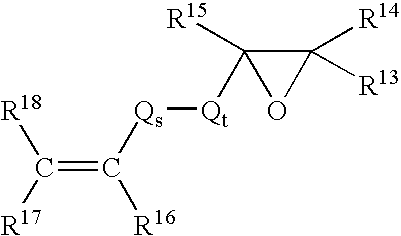Cosmetic compositions utilizing acrylate cross linked silicone copolymer networks
- Summary
- Abstract
- Description
- Claims
- Application Information
AI Technical Summary
Problems solved by technology
Method used
Image
Examples
example 1
Preparation of Polyacrylate Siloxane Copolymer Network Composition I in Water
[0157] 234.9 g of an organopolysiloxane with the approximate composition MD85D*2.2D″5.5M (D*: from the reaction of Si—H with 4-vinylcyclohexene-1,2-epoxide; D″: from the hydrosilylation of Si—H with allyl terminated polyether, CH2═CH—CH2—O-(EO)24(PO)27—CH3) and 29.5 g of acrylic acid were mixed. Approximately 20 mg of 4-methoxy phenol and 0.8 g of tetraisopropyl titanate were added. The mixture was heated to 90° C. for approximately 2 hours. Then 72 g of the resulting materials was mixed with 13.36 g of acrylic acid and 341 g of D. I. water. Nitrogen was bubbled through for 30 minutes to remove oxygen from the system. Then 0.86 g of ascorbic acid and 2.58 g of hydrogen peroxide were added. The mixture was stirred for approximately 2 hours to give an opaque soft solid.
example 2
Preparation of Polyacrylate Siloxane Copolymer Network Composition II in Silicone Fluid
[0158] 400 g of a silicone hydride fluid with the approximate composition MD125DH7.5M was mixed with 12.15 g of 4-vinylcyclohexene-1,2-epoxide and 746.55 g of allyl terminated polyether with the formula of CH2═CH—CH2—O-(EO)24(PO)27—CH3. The reaction was buffered with sodium propionate. The mixture was heated to 85° C. and 0.7 ml of platinum catalyst solution (10 mg / ml chloroplatinic acid in Ethanol) was added. The mixture was stirred at 90° C. for 3 hours to form an epoxy functional polyether-polysiloxane copolymer. The resulting copolymer was neutralized using sodium bicarbonate, vacuum stripped and filtered. Then 52.31 g of the resulting epoxy functional polyether-polysiloxane copolymer and 1.24 g of acrylic acid were mixed. Approximately 10 mg of 4-methoxy phenol and 0.1 g of tetraisopropyl titanate were added. The mixture was heated to 90° C. for approximately 2 hours. The mixture was then co...
example 3
Preparation of Polyacrylate Siloxane Copolymer Network Composition III in Silicone Fluid
[0159] 200 g of a silicone hydride fluid with the approximate composition MD200DH7.5M was mixed with 5.99 g of 4-vinylcyclohexene-1,2-epoxide and 84.34 g of allyl terminated polyether with the formula of CH2═CH—CH2—O-(EO)5(PO)5—CH3. The reaction was buffered with sodium propionate. The mixture was heated to 85° C. and 0.1 ml of platinum catalyst solution (10 mg / ml chloroplatinic acid in Ethanol) was added. The mixture was stirred at 80° C. for 3 hours to form an epoxy functional polyether-polysiloxane copolymer. The resulting copolymer was neutralized using sodium bicarbonate, vacuum stripped and filtered. Then 50.00 g of the resulting epoxy functional polyether-polysiloxane copolymer and 1.59 g of acrylic acid were mixed. Approximately 10 mg of 4-methoxy phenol and 0.1 g of tetraisopropyl titanate were added. The mixture was heated to 90° C. for approximately 2 hours. The mixture was then coole...
PUM
| Property | Measurement | Unit |
|---|---|---|
| Fraction | aaaaa | aaaaa |
| Fraction | aaaaa | aaaaa |
| Fraction | aaaaa | aaaaa |
Abstract
Description
Claims
Application Information
 Login to View More
Login to View More - R&D Engineer
- R&D Manager
- IP Professional
- Industry Leading Data Capabilities
- Powerful AI technology
- Patent DNA Extraction
Browse by: Latest US Patents, China's latest patents, Technical Efficacy Thesaurus, Application Domain, Technology Topic, Popular Technical Reports.
© 2024 PatSnap. All rights reserved.Legal|Privacy policy|Modern Slavery Act Transparency Statement|Sitemap|About US| Contact US: help@patsnap.com









